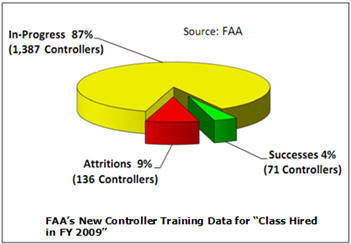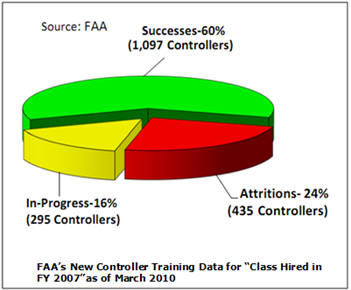|
|||||||||||||||||
|
|
|
|||
|
FAA Must Improve
Controller Training Metrics To Identify Program Needs By Mike Mitchell |
||||
 |
April 3, 2011 - Department of Transportation’s Office of
Inspector General (OIG) reports the FAA must improve its
controller training metrics to help identify program
needs. The
Federal
Aviation
Administration
(FAA)
plans
to
hire and
train
nearly 11,000 new air traffic controllers through
fiscal year (FY) 2019 to replace the large numbers of
those now retiring.
As
the FAA begins training this influx of new hires, it
must have accurate metrics on their training progress to
ensure that key air traffic control facilities have
enough controllers for safe and efficient operations.
In
2009, at the request of Representative Jerry F.
Costello, then Chairman of the House Subcommittee on
Aviation, OIG reviewed training failures among newly
hired air traffic controllers.
During that review, OIG found that the FAA’s reported
training failure rate was not accurate and that FAA’s
primary source of training failure data, the National
Training Database (NTD), contained outdated and
inaccurate data which are critical metrics for managing
this important program.
OIG audit objectives were to evaluate the FAA’s actions
to improve its system for tracking the training progress
of newly hired controllers and review the FAA’s metrics
for measuring and reporting the effectiveness of its
controller training program.
As a part of the evaluation, OIG examined the FAA’s methodology for calculating the training attrition and completion rates of developmental (new) controllers. OIG conducted this review between November 2009 and January 2011. |
|||
 |
||||
|
The results in brief identified that the FAA has improved its tracking process for new controller training over the last year. The Agency has taken a number of corrective actions to address the problems identified in 2009 that contributed to an inaccurate training failure rate reported for newly hired controllers. |
||||
|
These actions
include establishing a new Quality Assurance Group in March 2010 to
oversee NTD data collection, separately tracking new hires and veteran
controllers, distinguishing between training failures and other types of
attrition in the NTD, and issuing guidance to enforce data accuracy.
While these
actions are positive steps towards improving how it tracks the training
progress of newly hired controllers, FAA continues to face challenges in
identifying training program needs and measuring the overall success of
the training program.
FAA’s metrics for
measuring the effectiveness of the controller training program do not
provide a complete picture because they include controllers who have not
completed their initial training.
For example, if
there are 100 controllers in the training program and 9 of those
controllers fail or leave, FAA reports an attrition rate of 9 percent.
This produces unrealistic results because some of the remaining 91
in-progress controllers may also leave the program at a later time.
Eventually, all controllers in training will either be certified or leave the program, but because the FAA includes all in-progress controllers in its attrition rate, it dilutes the program’s actual loss and completion rates. As a result, the FAA cannot rely on these data to make appropriate and timely adjustments to the program.
When OIG assessed
the number of controllers who successfully completed training against
those who did not, they found a significantly higher attrition rate of
21 percent for newly hired controllers.
This presents a very different picture of success compared to the
9-percent attrition rate reported by FAA for FY 2009. Accurate training data are necessary so that FAA can adequately prepare new hires to replace retiring veteran controllers, assign new hires to the appropriate level and type of facility, and adjust its training program when warranted.
New
air traffic
controllers must
complete an
arduous training
program that
includes learning the basic concepts of air traffic control at the FAA
Academy, followed by extensive facility training at their assigned
location. Those controllers who are unable to pass the training process
are either
While
certification times for individual controllers may vary, the FAA’s goal
is to have terminal candidates who manage air traffic in the vicinity of
airports, complete the training process in 2 years, and en route
candidates, who manage high-altitude traffic in 3 years. The FAA has improved its tracking process for new controller training over the last year. The FAA has taken a number of actions in response to OIG June 2009 report to improve its tracking process for newly hired controllers in training.
The safety of the
National Airspace System relies on having a fully staffed, well- trained
air traffic controller workforce. To maintain the controller workforce
in light of recent increases in controller retirements, the FAA faces
tremendous challenges in executing its plans to train nearly 11,000 new
controllers over the next 10 years.
Having accurate
metrics to measure and report on the effectiveness of its controller
training program should be a critical component of that plan. However,
the FAA’s current metrics do not portray an accurate picture of the
program’s success. If the actual number of new controllers who do not
complete initial training is greater than the FAA anticipates, the
Agency runs the risk of not maintaining a sufficient number of fully
trained controllers at some of the most complex air traffic control
facilities in the National Airspace System. |
|
|
| ©AvStop
Online Magazine
Contact
Us
Return To News
|
|

